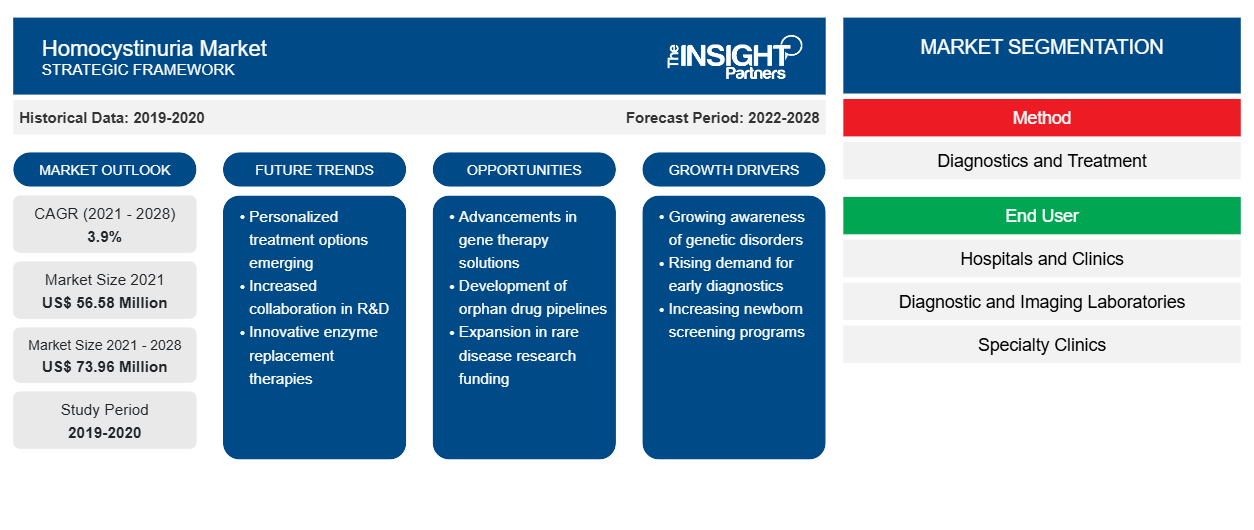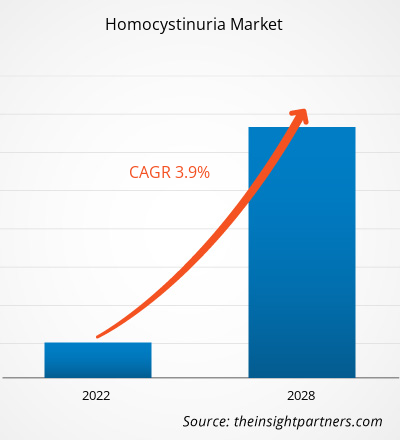Homocystinuria Market Size and Competitive Analysis by 2028
Historic Data: 2019-2020 | Base Year: 2021 | Forecast Period: 2022-2028Homocystinuria Market Forecast to 2028 - COVID-19 Impact and Global Analysis By Method (Diagnostics and Treatment) and End User (Hospitals and Clinics, Diagnostic and Imaging Laboratories, Specialty Clinics, and Academic and Research Institutes), and Geography
- Report Date : Dec 2021
- Report Code : TIPRE00026172
- Category : Life Sciences
- Status : Published
- Available Report Formats :


- No. of Pages : 226
The homocystinuria market is projected to reach US$ 73.96 million by 2028 from US$ 56.58 million in 2021; it is estimated to grow at a CAGR of 3.9% during 2021–2028.
Homocystinuria is a genetic condition in which the body is unable to correctly digest certain protein building blocks (amino acids). Homocystinuria comes in a variety of types, each with its own set of signs and symptoms as well as a hereditary aetiology. Nearsightedness (myopia), dislocation of the lens at the front of the eye, a greater risk of irregular blood clotting, and brittle bones prone to fracture (osteoporosis) or other skeletal abnormalities define the most prevalent form of homocystinuria. Some of the people who are impacted also have developmental delays and learning difficulties.
Customize This Report To Suit Your Requirement
You will get customization on any report - free of charge - including parts of this report, or country-level analysis, Excel Data pack, as well as avail great offers and discounts for start-ups & universities
Homocystinuria Market: Strategic Insights

-
Get Top Key Market Trends of this report.This FREE sample will include data analysis, ranging from market trends to estimates and forecasts.
The growth of the homocystinuria market is attributed to the rising deficiencies of vitamin B6 and Vitamin B12 and the growing prevalence of inherited metabolic disorders. However, the lack of awareness about various rare disorders and inherited metabolic disorders hampers the market growth.
Market Insights
Rising Vitamin B6 and Vitamin B12 Deficiencies Drive Homocystinuria Market
The increase in vitamin B6 and Vitamin B12 deficiencies patterns leads to several disorders such as anemia, megaloblastic anemia, microcytic anemia, and some kind of metabolic disorders, which is expected to boost the market growth during the forecast period. As vitamin B6 therapy is believed to be an effective therapy against homocystinuria, the deficiency of this vitamin may worsen the condition. Pyridoxine (vitamin B6) acts as a cofactor of beta-synthase and acts as a chaperone for stabilizing several missense mutations. Some of the patients with homocystinuria respond well to pyridoxine therapy, and it helps to lower the homocysteine levels, thereby providing relief from the condition. Thus, vitamin B6 is considered vital in managing homocystinuria as a limited number of treatments are available for curing the condition. The deficiency of this enzyme leads to anemia and microcytic anemia. The rising prevalence of anemia is expected to spur market growth during the forecast period. For instance, according to the World Health Organization, anemia affects over 1.62 billion populations, i.e., 24.8% of the population. The major causes of anemia are improper diet and deficiencies of vitamins such as B6, B9, and B12. Predominantly, vitamin B6 deficiency is a leading cause of anemia. Thus, an increase in cases of vitamin B6 deficiency and a high prevalence of disorders associated with its deficiency is expected to support market growth during the forecast period.
Method-Based Insights
The global homocystinuria market, based on method, is bifurcated into treatment and diagnostics. The treatment segment held a larger share of the market in 2021. Moreover, the same segment is anticipated to register a higher CAGR in the market during the forecast period due to the incumbent usage of treatment and increasing research and development of new treatments for homocystinuria.
Homocystinuria Market Regional InsightsThe regional trends and factors influencing the Homocystinuria Market throughout the forecast period have been thoroughly explained by the analysts at The Insight Partners. This section also discusses Homocystinuria Market segments and geography across North America, Europe, Asia Pacific, Middle East and Africa, and South and Central America.
Homocystinuria Market Report Scope
| Report Attribute | Details |
|---|---|
| Market size in 2021 | US$ 56.58 Million |
| Market Size by 2028 | US$ 73.96 Million |
| Global CAGR (2021 - 2028) | 3.9% |
| Historical Data | 2019-2020 |
| Forecast period | 2022-2028 |
| Segments Covered |
By Method
|
| Regions and Countries Covered |
North America
|
| Market leaders and key company profiles |
|
Homocystinuria Market Players Density: Understanding Its Impact on Business Dynamics
The Homocystinuria Market is growing rapidly, driven by increasing end-user demand due to factors such as evolving consumer preferences, technological advancements, and greater awareness of the product's benefits. As demand rises, businesses are expanding their offerings, innovating to meet consumer needs, and capitalizing on emerging trends, which further fuels market growth.

- Get the Homocystinuria Market top key players overview
End-User-Based Insights
The global homocystinuria market, based on end-user, is segmented into diagnostics and imaging laboratories, hospitals and clinics, specialty clinics, and academic and research institutes. In 2021, the diagnostics and imaging laboratories segment held the largest share of the market. Moreover, the segment is expected to register the highest CAGR of 4.2% during 2021–2028 due to the rising diagnosis of inherited metabolic disorders in diagnostics and imaging laboratories.
Product launches and approvals are commonly adopted strategies by companies to expand their global footprints and product portfolios. Moreover, the homocystinuria market players focus on the partnership strategy to enlarge their clientele, which, in turn, permits them to maintain their brand name across the world.
The report segments homocystinuria market as follows
Homocystinuria Market – by Method
- Treatment
- Pyridoxine
- Betaine
- Others
- Diagnostics
- Genetic Testing
- Amino Acid Screening Test
- Liver Enzyme Test
- Others
Homocystinuria Market – by End User
- Hospitals and Clinics
- Diagnostic and Imaging Laboratories
- Specialty Clinics
- Academic and Research Institutes
Homocystinuria Market – by Geography
- North America
- US
- Canada
- Mexico
- Europe
- UK
- Germany
- France
- Italy
- Spain
- Rest of Europe
- Asia Pacific
- China
- Japan
- India
- Australia
- South Korea
- Rest of Asia Pacific
- Middle East and Africa
- UAE
- Saudi Arabia
- South Africa
- Rest of Middle East and Africa
- South and Central America
- Brazil
- Argentina
- Rest of South and Central America
Company Profiles
- BASF SE
- HUAZHONG PHARMACEUTICAL
- Pfizer Inc.
- MYLAN N.V
- Aeglea BioTherapeutics
- Amino GMBH
- KAO Corporation
- DSM Corporation
- Orphan Technologies
- Fresenius Kabi AG
Frequently Asked Questions
Which is the potential market for the Homocystinuria in terms of region??
What does Homocystinuria mean?
What are the driving factors for the Homocystinuria market across the globe?
What is the market CAGR value of Homocystinuria market during forecast period?
What are future trends of Homocystinuria market?
Mrinal is a seasoned research analyst with over 8 years of experience in Life Sciences Market Intelligence and Consulting. With a strategic mindset and unwavering commitment to excellence, she has built deep expertise in pharmaceutical forecasting, market opportunity assessment, and developing industry benchmarks. Her work is anchored in delivering actionable insights that empower clients to make informed strategic decisions.
Mrinal’s core strength lies in translating complex quantitative datasets into meaningful business intelligence. Her analytical acumen is instrumental in shaping go-to-market (GTM) strategies and uncovering growth opportunities across the pharmaceutical and medical device sectors. As a trusted consultant, she consistently focuses on streamlining workflow processes and establishing best practices, thereby driving innovation and operational efficiency for her clients.
- Historical Analysis (2 Years), Base Year, Forecast (7 Years) with CAGR
- PEST and SWOT Analysis
- Market Size Value / Volume - Global, Regional, Country
- Industry and Competitive Landscape
- Excel Dataset
Testimonials
The Insight Partners' SCADA System Market report is comprehensive, with valuable insights on current trends and future forecasts. The team was highly professional, responsive, and supportive throughout. We are very satisfied and highly recommend their services.
RAN KEDEM Partner, Reali Technologies LTDsI requested a report on a very specific software market and the team produced the report in a few days. The information was very relevant and well presented. I then requested some changes and additions to the report. The team was again very responsive and I got the final report in less than a week.
JEAN-HERVE JENN Chairman, Future AnalyticaWe worked with The Insight Partners for an important market study and forecast. They gave us clear insights into opportunities and risks, which helped shape our plans. Their research was easy to use and based on solid data. It helped us make smart, confident decisions. We highly recommend them.
PIYUSH NAGPAL Sr. Vice President, High Beam GlobalThe Insight Partners delivered insightful, well-structured market research with strong domain expertise. Their team was professional and responsive throughout. The user-friendly website made accessing industry reports seamless. We highly recommend them for reliable, high-quality research services
YUKIHIKO ADACHI CEO, Deep Blue, LLC.This is the first time I have purchased a market report from The Insight Partners.While I was unsure at first, I visited their web site and felt more comfortable to take the risk and purchase a market report.I am completely satisfied with the quality of the report and customer service. I had several questions and comments with the initial report, but after a couple of dialogs over email with their analyst I believe I have a report that I can use as input to our strategic planning process.Thank you so much for taking the extra time and making this a positive experience.I will definitely recommend your service to others and you will be my first call when we need further market data.
JOHN SUZUKI President and Chief Executive Officer, Board Director, BK TechnologiesI wish to appreciate your support and the professionalism you displayed in the course of attending to my request for information regarding to infectious disease IVD market in Nigeria. I appreciate your patience, your guidance, and the fact that you were willing to offer a discount, which eventually made it possible for us to close a deal. I look forward to engaging The Insight Partners in the future, all thanks to the impression you have created in me as a result of this first encounter.
DR CHIJIOKE ONYIA MANAGING DIRECTOR, PineCrest Healthcare Ltd.Reason to Buy
- Informed Decision-Making
- Understanding Market Dynamics
- Competitive Analysis
- Identifying Emerging Markets
- Customer Insights
- Market Forecasts
- Risk Mitigation
- Boosting Operational Efficiency
- Strategic Planning
- Investment Justification
- Tracking Industry Innovations
- Aligning with Regulatory Trends




















 Get Free Sample For
Get Free Sample For